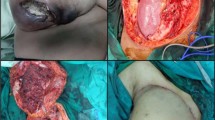Abstract
Background
The thoracic cavity was considered as a forbidden area in the past and anyone attempting to meddle with it was expected to be doomed. But the past several decades have seen a marked improvement in the management and reconstruction of complex chest wall defects. This study was undertaken to review our experience in chest wall reconstruction during the past 12 years and to stress upon the importance of a multidisciplinary team approach to this complex problem.
Methods
After obtaining the necessary clearance from institutional ethics committee, we did a retrospective review of all case records of chest wall reconstructions (CWR) performed in our institution during a 12-year period from May 2005 to September 2016. Patient characteristics, co-morbidities, operative data and post-operative complications and outcomes were reviewed.
Results
During the study period, a total of 32 patients underwent CWR. All patients were assessed, planned, operated and managed by a team consisting of thoracic surgeons, plastic surgeons, intensivists and pulmonologists. Patients were in the age group of 14–72 with a male:female ratio of 15:17. Indications for CWR were neoplasms (n = 13–40.62%), post-sternotomy wound dehiscence (n = 12–37.5%), osteoradionecrosis (n = 4–12.5%), tuberculosis (n = 2–6.25%) and osteomyelitis rib (1/32–3.125%). Inflammatory defects were mostly closed with soft tissue alone whereas skeletal stabilisation with soft tissue cover was required in tumour resections. All were pedicled flaps, the most common being pectoralis major (PM) muscle flap (n = 12). Others include latissimus dorsi (LD) muscle (n = 9); rectus abdominis (RA) muscle (n = 2); transverse rectus abdominis musculocutaneous flap (TRAM) (n = 2), deltopectoral (DP) (n = 1), omentum (n = 3) and breast flap (n = 3). Post-operative complications include wound dehiscence (12%), wound infection (21%) and recurrent sinus formation (7%). One partial flap failure was recorded. Post-operative mortality was 3%.
Conclusion
Chest wall reconstruction is a complex procedure and each defect needs an individualised approach for optimum outcome. Extensive chest wall resections can be safely undertaken with the support of the reconstructive surgeon and with good critical care back up.




Similar content being viewed by others
References
Clemens MW, Evans KK, Mardini S, Arnold PG. Introduction to chest wall reconstruction: anatomy and physiology of the chest and indications for chest wall reconstruction. Semin Plast Surg. 2011;25:5–15.
Stenton C. The MRC breathlessness scale. Occup Med. 2008;58:226–7.
Sanna S, Brandolini J, Pardolesi A, et al. Materials and techniques in chest wall reconstruction: a review. J Vis Surg. 2017;3:95.
Puvvala S, Subramanyam GM, Suraparaju SS. Primary chest wall neoplasms—resection and reconstruction. Indian J Thorac Cardiovasc Surg. 2016;32:184–8.
McKenna RJ Jr, Mountain CF, McMurtrey MJ, Larson D, Stiles QR. Current techniques for chest wall reconstruction: expanded possibilities for treatment. Ann Thorac Surg. 1988;46:508–12.
Izaddoost S, Withers EH. Sternal reconstruction with omental and pectoralis flaps: a review of 415 consecutive cases. Ann Plast Surg. 2012;69:296–300.
van Wingerden JJ , Lapid O, Boonstra PW, de Mol BA. Muscle flaps or omental flap in the management of deep sternal wound infection. Interact Cardiovasc Thorac Surg. 2011;13:179–87.
Tukiainen E. Chest wall reconstruction after oncological resections. Scand J Surg. 2013;102:9–13.
Raz DJ, Clancy SL, Erhunmwunsee LJ. Surgical management of the radiated chest wall and its complications. Thorac Surg Clin. 2017;27:171–9.
Matros E, Disa JJ. Uncommon flaps for chest wall reconstruction. Semin Plast Surg. 2011;25:55–9.
Mayer HF, De Belaustegui EA, Loustau HD. The contralateral breast flap in autologous breast reconstruction. J Plast Reconstr Aesthet Surg. 2016;69:876–7.
Gingrass RP. Breast flaps, Ch. 404. In: Lee BT, Strauch B,Vasconez LOH,KC, editors. Grabb’s encyclopedia of flaps volume 2. 4th ed: Lippincott Williams & Wilkins (LWW); 2015.
Netscher DT, Izaddoost S, Sandvall B. Complications, pitfalls, and outcomes after chest wall reconstruction. Semin Plast Surg. 2011;25:86–97.
Funding
Nil
Author information
Authors and Affiliations
Corresponding author
Ethics declarations
Ethical standards
This retrospective review was in concordance to the guidelines of Institutional Review Board of our institution.
Informed consent
Informed consent in mother tongue was obtained in all cases.
Conflict of interest
The authors declare that they have no conflict of interest.
Additional information
Publisher’s note
Springer Nature remains neutral with regard to jurisdictional claims in published maps and institutional affiliations.
Rights and permissions
About this article
Cite this article
Malathi, L., Das, S., Nair, J.T.K. et al. Chest wall reconstruction: success of a team approach—a 12-year experience from a tertiary care institution. Indian J Thorac Cardiovasc Surg 36, 44–51 (2020). https://doi.org/10.1007/s12055-019-00841-y
Received:
Revised:
Accepted:
Published:
Issue Date:
DOI: https://doi.org/10.1007/s12055-019-00841-y




